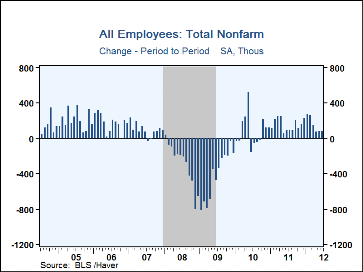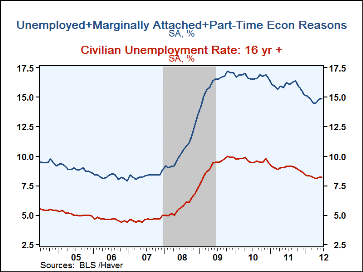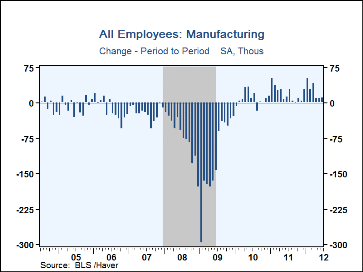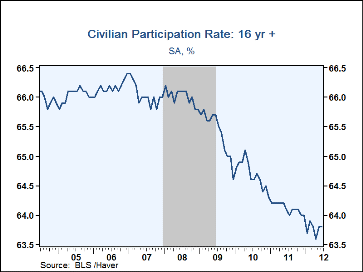 Global| Jul 06 2012
Global| Jul 06 2012U.S. Nonfarm Payroll Growth Continues Lethargic
by:Tom Moeller
|in:Economy in Brief
Summary
The job market remained under pressure last month. Nonfarm payrolls grew just 80,000 following gains of 77,000 and 68,000 during the prior two months, revised from 69,000 and 77,000, respectively. A 90,000 increase was expected for [...]
The job market remained under pressure last month. Nonfarm payrolls grew just 80,000 following gains of 77,000 and 68,000 during the prior two months, revised from 69,000 and 77,000, respectively. A 90,000 increase was expected for June. Job creation was weak across industries. The unemployment rate held steady at 8.2% and matched expectations.
From the payroll jobs survey, employment rose 80,000 and pulled three-month average job growth to 75,000, the least since October 2010. Weakness spread throughout industries. Factory sector jobs grew 11,000 last month with three month growth a moderate 10,000. Construction jobs ticked up 2,000 but over three months jobs fell an average 13,000. Private service sector employment rose just 71,000. The 93,000 average gain over the last three months is half this winter's high.
Also, employment of temporary workers rose 25,000 (10.7% y/y). The number of public sector jobs continued to decline. The 4,000 worker drop (-0.8% y/y) in June rounded out a 16,000 average decline over three months. It's been evenly shared by government sectors. The diffusion index of job change showed that just 58.1% of private industries added jobs over the last three months, the least since late 2010.
To the upside, the average workweek in private industry rose to 34.5 and recovered its May decline. The gain was led by a jump in professional & business services. Elsewhere, hours worked were flat m/m or up just slightly.
Average hourly earnings rose a better-than-expected 0.3% (1.5% y/y). The gain was the firmest since July and led by a 0.5% increase (2.0% y/y) in trade, transportation & utilities and a 0.4% gain (4.3% y/y) in financial services.
From the household jobs survey, the unemployment rate held steady m/m at 8.2%, nearly its lowest of the recovery. The rate, including individuals working part-time for economic reasons and those marginally attached, rose to 14.9% -- its highest since February. Employment gained 128,000 (2.2% y/y) and the labor force increased 156,000 (1.1% y/y). The labor force participation rate held steady m/m at 63.8% versus its 2006 high of 66.2%. The participation rate is currently the lowest since 1983. The average duration of unemployment ticked up m/m to 39.9 weeks. That compares to 17.8 weeks in 2008. The percent of those unemployed for 52 weeks or longer fell to 28.5%.
The figures referenced above are available in Haver's USECON database. Additional detail can be found in the LABOR and in the EMPL databases. The expectation figures are from Action Economics and are in the AS1REPNA database.
| Employment: (M/M Chg., 000s) | Jun | May | Apr | Y/Y | 2011 | 2010 | 2009 |
|---|---|---|---|---|---|---|---|
| Payroll Employment | 80 | 77 | 68 | 1.4% | 1.2% | -0.7% | -4.4% |
| Previous | -- | 69 | 77 | -- | -- | -- | -- |
| Manufacturing | 11 | 9 | 10 | 1.9 | 1.8 | -2.7 | -11.6 |
| Construction | 2 | -35 | -7 | 0.3 | -0.3 | -8.2 | -16.0 |
| Private Service Producing | 71 | 126 | 81 | 1.8 | 1.8 | -0.1 | -3.5 |
| Government | -4 | -28 | -17 | -0.8 | -1.7 | -0.3 | 0.2 |
| Average Weekly Hours - Private Sector | 34.5 | 34.4 | 34.5 | 34.4 (Jun'11) |
34.4 | 34.1 | 33.9 |
| Average Hourly Earnings (%) | 0.3 | -0.1 | 0.2 | 1.5 | 2.0 | 2.4 | 3.0 |
| Unemployment Rate (%) | 8.2 | 8.2 | 8.1 | 9.1 (Jun'11) |
9.0 | 9.6 | 9.3 |
Tom Moeller
AuthorMore in Author Profile »Prior to joining Haver Analytics in 2000, Mr. Moeller worked as the Economist at Chancellor Capital Management from 1985 to 1999. There, he developed comprehensive economic forecasts and interpreted economic data for equity and fixed income portfolio managers. Also at Chancellor, Mr. Moeller worked as an equity analyst and was responsible for researching and rating companies in the economically sensitive automobile and housing industries for investment in Chancellor’s equity portfolio. Prior to joining Chancellor, Mr. Moeller was an Economist at Citibank from 1979 to 1984. He also analyzed pricing behavior in the metals industry for the Council on Wage and Price Stability in Washington, D.C. In 1999, Mr. Moeller received the award for most accurate forecast from the Forecasters' Club of New York. From 1990 to 1992 he was President of the New York Association for Business Economists. Mr. Moeller earned an M.B.A. in Finance from Fordham University, where he graduated in 1987. He holds a Bachelor of Arts in Economics from George Washington University.












